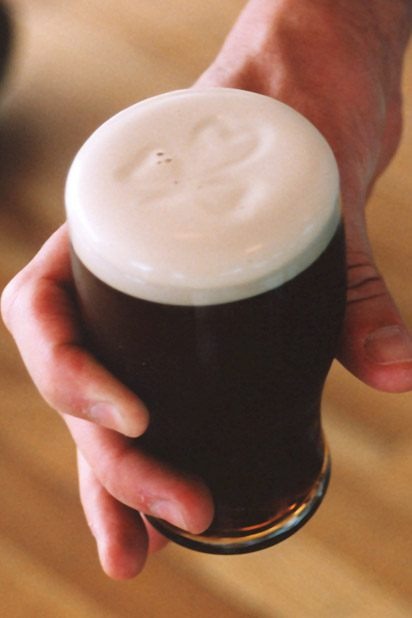Beer And Cheese: A Surprisingly Happy Marriage
When it comes to pairing cheese, I always think of wine. So, when Martin Johnson, a cheese aficionado and consultant with over 20 years of experience, recently paired up with Ray Deter, the owner of d.b.a. Brooklyn (also New York and New Orleans) and a beer and spirits geek, to lead an exploration pairing Porters, Stouts, and other dark beers with nutty Alpine cheeses, I had to check it out and find more.
What do we mean when we say "Alpine" cheeses? It applies to both cheeses made in Alpine regions, like in the Savoie, and to the technique used in producing the cheese. Gruyere may be the best known example of an "alpine" cheese. Traditionally, when making gruyere, the curds are heated and pressed in molds. After brining, these are left to "ripen" for a couple of months, then are left to "cure," where the flavor intensifies, for anywhere between 3 and 10 months. Many well-known and loved cheeses have their origins in the Alpine style; one example is Parmigiano-Reggiano, an Italian interpretation. Alpine cheeses are characterized by a very nutty flavor, a grassy finish, and sometimes a slightly crunchy texture, from clusters of tyrosine left behind from the aging of the protein and fat chains in the cheese, but no, fear—this is a sign of a well-aged drink.
These nutty Alpine cheeses pair beautifully with deep, dark Stouts and Porters, characteristically full of rich coffee or chocolate flavors. Dark beers get their color from roasting the malt used for longer, resulting in smokier, richer flavors and colors. So, what's the difference between these two dark beers? Porters are characterized by a balanced sweet and bitterness—the sweet caramel or chocolaty richness from the roasted malt mellowing the bitterness from the hops. Stouts, you may find, have more of a coffee-like flavor, due to the addition of roasted barley. Other than that, they're pretty much the same.
Pairing Beer and Cheese
When it comes to pairing beers and cheeses on your own, it's not as difficult as one may think. Martin even thinks it may be more difficult to pair wines with cheese, especially red burgundies. Often, when pairing a beverage with a cheese, one will pair according to terroir, pairing cheeses and wines from the same region together. Or, they'll opt for flavors, pairing buttery cheeses with buttery wines like oaked Chardonnay. Martin and Ray, however, agree that following those guidelines may result in the best pairings. When they match a wine—or beer, in this case—together, they look for complementary flavors; taste qualities that will excite the whole palate. A properly paired beer will mellow any pungent cheese flavors, while the cheese brings out hidden flavors in the beer. As an example, here are the cheeses—and their paired beers—that were served:
Spring Brook Tarentaise: An award-winning alpine cow's milk cheese that is smooth and nutty, with a hint of minerality.
Paired with: Fuller's London Porter, a delicate, lightly coffee-flavored beer from the last privately owned brewery in London.
Tome d'Aquitaine: A new alpine-style goat's milk washed-rind cheese from the Savoie; also known as Clisson.
Paired with: Brooklyn Winter Ale, a fruity beer made in Brooklyn, NY in the classic English Ale tradition.
Spicherhalde Alpkase: a creamy gruyere-style alpine cheese with a slight grassy finish from the Austrian/Bavarian border.
Paired with: Stone Smoked Porter, an opaque smoky-chocolaty stout, made with smoked malt, which perfectly mellows the flavorful cheese.
Senne Flada: a creamy (like a Brie), barnyard-y soft cheese from Switzerland that loves pairing with beer.
Paired with: Guinness Foreign Extra, a beer developed over 200 years ago for foreign export, and wasn't available in the States until just recently. The caramel-sweetness of the beer perfectly complements the earthy-barnyard flavors of the creamy cheese.
Pleasant Ridge Reserve: A much-beloved cheese from Wisconsin (it's even sold in Switzerland and France) that cleans up every year at the American Cheese Society judging; made in the style of Beaufort, it is densely textured, with a bit of crunchiness.
Paired with: 21st Century Fireside Chat, a spiced, slightly sweet, very deeply favored English-style ale.
Mystery Cheese: Martin decided to test us. Though many of us thought it was a sheep's milk cheese, it was very creamy, not too pungent, and showed its age with a bit of crunch. Surprise, surprise: it was a gruyere, slightly milder than the classic gruyere, which was coddled by affineur Rolf Beeler.
Paired with: Spectrum Black Buffle, a "warm and kind of flat" beer, as characterized by Ray (it's served this way in England often, as the aromas and flavors are more pronounced when the beer isn't cold). This smooth stout is offered by the cask at d.b.a.—and it's the only cask in the country!
Jersey Blue: A creamy, slightly sweet, earthy-peppery Swiss blue cheese made from the milk of Jersey cows.
Paired with: Riverhorse Belgian Freeze, a full-flavored beer whose sweetness beautifully complements the pepperiness of the blue cheese. It also goes really, really well with City Bakery's chocolate-chip and chocolate-chocolate-chip cookies, we learned, as the evening closed with a bite of each.
When creating a beer and cheese pairing of your own at home, first visit your local cheesemonger and share your idea with them; they should be able to offer some suggestions. As well, you can pick a couple of beers, maybe some you love—or test out a couple of new ones—then, knowing the flavor profile of each beverage, take those notes with you to the cheese counter. Whichever way you choose, make sure you have fun with your pairings—it is beer and cheese, after all.
Have more questions, or want to broaden your palate? If you live in New York, d.b.a. Brooklyn offers "Cheesy Mondays" at the bar. Even if you don't like cheese (or beer), they've also got warm pretzels and hot mulled cider—and whisky. You can also find Martin Johnson hosting monthly wine and cheese pairings at 10 Degrees Bar in Manhattan.
